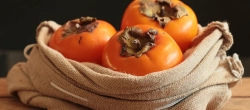Category: Fruits and Berries
Persimmon: Taste, Uses, and Benefits
Persimmon, a vibrant, orange fruit native to East Asia, is celebrated for its sweet and honey-like flavor. It has a unique taste profile that varies with ripeness, making it a versatile fruit for both fresh eating and cooking. Known for its smooth texture and subtle spiciness, persimmon is used in both sweet and savory dishes, adding a distinctively sweet and fruity touch.
What does Persimmon taste like?
Primary Flavor Characteristics
Persimmons have a honeyed sweetness with a slightly floral and fruity taste, often compared to a mix of apricots and honeydew melon. When fully ripe, the flavor is intensely sweet and smooth, while unripe persimmons are notably astringent, giving them a sharp, dry taste.
Aromatic and Taste Nuances
The aroma of persimmon is subtly floral with a hint of spice, complementing its sweet and mild flavor. Some varieties may have faint notes of vanilla or caramel, which become more prominent as the fruit ripens.
Scientific Description of Taste and Aroma
- Aroma: Lightly floral with hints of spice and caramel.
- Taste: Sweet, honeyed, and subtly fruity when ripe; astringent and sharp when unripe.
- Texture: Smooth and custard-like when ripe; firm and crisp when unripe.

In-Depth Flavor Analysis of Persimmon
Underlying Flavor Notes
The flavor profile of persimmon includes several layers:
- Honeyed Sweetness: Ripe persimmons are exceptionally sweet, with a taste reminiscent of honey.
- Floral Undertones: A subtle floral aroma adds complexity to the fruit's natural sweetness.
- Astringency in Unripe Fruit: Unripe persimmons contain tannins that create a dry, puckering sensation.
- Spicy Undertones: Some varieties have faint, spicy notes that enhance the overall flavor profile.
Impact of Ripeness on Flavor
- Unripe Persimmon: Firm texture and high astringency, resulting in a dry, bitter taste.
- Fully Ripe Persimmon: Soft, custard-like flesh with intense sweetness and a smooth, rich flavor.
Textural Qualities
Ripe persimmons have a soft, creamy texture, almost like custard, while unripe persimmons are crisp and firm. This textural contrast makes persimmons suitable for various culinary uses.
Culinary Uses of Persimmon
Primary Uses
- Fresh Eating: Ripe persimmons are often eaten fresh, providing a naturally sweet, honeyed snack.
- Salads and Salsas: Sliced persimmons add sweetness and color to salads, pairing well with greens and citrus.
- Desserts and Baked Goods: Persimmons add moisture and a unique flavor to cakes, pies, and puddings.
- Smoothies and Beverages: Blended into smoothies, persimmons add a smooth, sweet flavor and creamy texture.
- Savory Dishes: Used in salsas, chutneys, and as a garnish for roasted meats, persimmons balance savory flavors with their sweetness.
Ideal Pairings for Persimmon
- Citrus Fruits: Orange and lemon enhance persimmons’ natural sweetness and add brightness.
- Spices: Cinnamon, nutmeg, and clove complement the warm, honeyed flavor of persimmons in desserts.
- Nuts: Walnuts, almonds, and pecans add a crunchy texture and earthy flavor contrast.
- Cheese: Creamy cheeses like brie and goat cheese pair well with persimmons in salads or on cheese boards.
- Herbs: Fresh herbs like mint and basil add freshness and balance the sweetness of persimmons.
Health Benefits of Persimmon
Key Nutrients and Benefits
- Rich in Vitamin C: Persimmons are high in vitamin C, which supports immune health and skin vitality.
- High in Fiber: The fiber content in persimmons aids in digestion and supports heart health.
- Antioxidants: Persimmons contain antioxidants, including beta-carotene, which help protect cells from oxidative damage.
- Supports Vision Health: The beta-carotene in persimmons supports eye health and may help reduce the risk of age-related vision decline.
- Low in Calories: Persimmons are naturally low in calories, making them a great addition to a balanced diet.
Potential Precautions
- High Natural Sugars: Ripe persimmons are high in natural sugars, so those monitoring blood sugar should consume them in moderation.
- Astringency in Unripe Persimmons: The high tannin content in unripe persimmons can cause an astringent, drying sensation in the mouth.

Tips for Choosing and Storing Persimmons
How to Choose Quality Persimmons
- Color and Firmness: Look for deep orange persimmons. Hachiya persimmons should feel soft when ripe, while Fuyu persimmons can be eaten firm or soft.
- Avoid Bruises: Check for smooth skin without bruises or soft spots.
Storage Recommendations
- At Room Temperature: Store unripe persimmons at room temperature until they soften.
- Refrigeration: Ripe persimmons can be refrigerated for up to a week to maintain freshness.
Fun Facts About Persimmons
- Ancient Origins: Persimmons have been cultivated in Asia for thousands of years and are highly valued in East Asian cultures.
- Two Main Varieties: The two main types are Hachiya (astringent) and Fuyu (non-astringent), each with unique uses and flavors.
- Natural Sweetener: Ripe persimmons can be used as a natural sweetener in desserts and beverages.